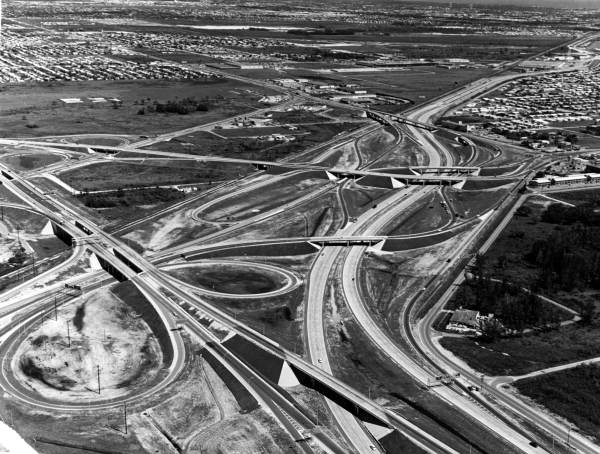Physical Address
304 North Cardinal St.
Dorchester Center, MA 02124
Physical Address
304 North Cardinal St.
Dorchester Center, MA 02124

Should YIMBYs support or oppose greenfield growth? Two basic values animate most YIMBYs: housing affordability and urbanism. Sprawl puts those values into tension. Let’s take as a given that sprawl is “bad” urbanism, mediocre at best. Realistically, it’s rarely going to be transit-oriented, highly walkable, or architecturally profound. So the question is whether outward, greenfield growth is necessary to achieve affordability. And the answer from urban economics is yes. You can’t get far in making a city affordable without letting it grow outward. Model 1: All hands on deck Let’s start with a nonspatial model where people demand housing space and it’s provided by both existing and new housing. Existing housing doesn’t easily disappear, so the supply curve is kinked. A citywide supply curve is the sum of a million little property-level supply curves. We can split it into two groups: infill and greenfield, which we add horizontally. If demand rises to the new purple line, you can see that the equilibrium point where both infill & greenfield are active is at a lower price & higher quantity than the infill-only line. The only way to get some infill growth to replace some greenfield growth, in this model, is to raise the overall price level. And even then, the replacement is less than 1-for-1. Of course, this is just a core YIMBY idea reversed! In most U.S. cities, greenfield growth has been allowed and infill growth sharply constrained, so that prices are higher, total growth is lower, and greenfield growth is higher than if infill were also allowed. At the most basic level, greenfield growth is simply one of the ways to meet demand. With fewer pumps working, you’ll drain less of the flood. Model 2: Paying for what you demolish Now let’s look at a spatial model where people […]

There’s been an ongoing debate in urbanist circles about whether autonomous vehicles (AVs) will damn us to perpetual sprawl and super commuting. I don’t believe that they will. In the first place, the business conditions under which AVs could conceivably induce more sprawl are unlikely. And in the second, there are numerous other factors that will affect the future of urban development in the US. That’s not to say we won’t double down on past mistakes, but it won’t be AVs that single handedly bring about that future on their own. No One Wants To Sell You a Self Driving Car For AVs to even begin to induce more sprawl, they need to facilitate super commuting. For that to happen at any significant scale, they need to be ubiquitous and privately owned. And that is something I don’t think we’re going to see for one simple reason — it’s a product no one is selling. Ole Muskie notwithstanding, no one with capital to burn thinks selling private AVs is a winning strategy (with good reason). Given the accumulated R&D costs of the last several years, the price a firm would need to charge for the first generation of personal AVs would be astronomical. Moreover, a company selling personal AVs would give up on mountains of valuable data generated as the vehicle racked up mileage. Trip data feeds back in to improving the ability of AVs to navigate and data about consumer habits is valuable as well. We should also remember that the state of AV technology is still quite…meh. And in the absence of a step function improvement in the technology, the fastest way to get to market is to restrict the problem space. That means means a driverless TNC service that can be limited to trips in certain areas […]

How much should we blame planning for the degree to which cities sprawl? As much time as we (justifiably) spend here on this blog explaining how conventional U.S. planning drives excessive sprawl, it’s worth periodically remembering that, at the end of the day, the actual extent of the horizontal expansion of cities is largely outside the control of urban planning. Consider Houston. Whenever I say anything nice about Houston’s relatively liberal approach to land-use regulation, someone invariably comments some variation of the following: “Yes, that’s all well and good in theory. But in practice, heavily regulated cities like Boston are far more urban and walkable, so maybe relaxed land-use regulations aren’t so great.” Indeed, most of Houston is classic sprawl. But this begs the question: to what extent can urban planning policy be blamed for sprawl? The urban economist Jan Brueckner, drawing on an extensive literature, distinguishes between the “fundamental forces” that naturally drive urban growth outward and the market failures that push this growth beyond what might occur in an appropriately regulated market. (For the purposes of this post, I’ll be using “sprawl” and “horizontal urban expansion” interchangeably. In the same paper, Brueckner thoughtfully distinguishes the two.) The latter, urban planners can address. The former, not so much. Let’s look first at the “fundamental” variables that planners have little to no control over. Brueckner identifies three: population growth, rising income, and falling commuting costs. The first variable is obvious: as cities grow, demand for all housing goes up, and some of that housing goes out on the periphery regardless of planning policy. Metropolises like Houston, Dallas, and Atlanta are currently experiencing 2% population growth every year, meaning they are on track to double in population in the next 35 years. You would expect a lot of horizontal expansion, all else […]

I am happy to announce that my new book “Government Intervention and Suburban Sprawl: The Case for Market Urbanism” is now available at Amazon. There is a “look inside the book” feature at the book’s Amazon webpage for those who would like to know more. I would like to thank not just the readers of this blog who commented on drafts, but also on those of you who helped me refine my thinking by commenting on blog posts.
Because of work obligations, I listened to only about a third of today’s Cato Institute discussion on urban sprawl. I heard some of Randall O’Toole’s talk and some of the question-and-answer period. O’Toole said high housing prices don’t correlate with “zoning” just with “growth constraints.” But the cities with strict regionwide growth constraints aren’t necessarily high cost cities like New York and Boston, but mid-size, moderately expensive regions like Seattle and Portland. He says that if land use rules raise housing prices they violate the Fair Housing Act. Maybe this should be the case, but it isn’t. Government can still regulate in ways that raise housing prices, but just have to show reasonable justification for those policies under “disparate impact” doctrine. He also says cities would be less dense without zoning. Is he aware that most city regulations limit density rather than mandating density? O’Toole says growth constraints are why American home ownership rates are lower than in Third World countries and that the natural rate of home ownership is 75 percent. But why are home ownership rates so low in sprawling Sun Belt cities? For example, metro Houston’s home ownership rate is about 59 percent – higher than New York or San Francisco, but lower than Philadelphia or Pittsburgh. The highest home ownership rates are in Rust Belt regions like Akron, I suspect because of low levels of mobility. Some things he gets right: 1) public participation in land use process is harmful because it leads to more restrictions, not less; (2) the mortgage interest deduction doesn’t make much difference in home ownership rates.
The Austin area has, for the 5th year running, been among America’s two fastest-growing major metro areas by population. Although everybody knows about the new apartments sprouting along transportation corridors like South Lamar and Burnet, much of the growth has been in our suburbs, and in suburban-style areas of the city. Our city is growing out more than up. How come? The desire for living in central Austin has never been higher. But Austin, like most cities, has rules that prevent new housing from getting centrally built. That makes it easier to buy and build on virgin land in the suburbs. Here are some of those rules. 1 MINIMUM LOT SIZE Historically, expensive houses were built on expensive, large lots; cheaper homes were built on smaller, cheaper lots. Austin decided that new houses can’t be built on small lots. Even if you want to build a small, cheap house, you still need a lot with at least 5,750 square feet. In central Austin, that costs a lot of money, even without the house! If somebody owns a 10,000 square foot lot, they aren’t allowed to split it into two 5,000 square foot lots and build two medium-sized houses, let alone three 3,333 square foot lots with three small houses, let alone three 3,333 square foot lots with triplexes! In 1999, Houston reformed its minimum lot size laws. Since then, environmentally-friendly central-city urban townhomes have flourished. 2 MINIMUM SITE AREA For areas that are zoned for apartments and condos, there is a cap on the ratio of number of apartments to lot size known as “minimum site area.” 3 IMPERVIOUS COVER MAXIMUMS Impervious cover is any surface that prevents water from seeping into the ground, including buildings, driveways, and garages. There is a cap on the ratio of impervious cover to lot size. 4 FLOOR-TO-AREA RATIO MAXIMUMS Floor-to-area ratios (aka FAR) maximums are a cap on […]

Currently, the American public school system is a sprawl-generating machine: urban public schools are less appealing to middle-class parents than suburban public schools, causing parents to move to suburbia. This result arises from school assignment laws: because students must attend school in the municipality of their residence, residents of the most diverse municipalities (usually central cities) must attend diverse schools. By definition, diverse schools have lots of children from disadvantaged backgrounds. Because children from disadvantaged backgrounds often learn less rapidly than middle-class children, these schools quickly get a reputation as “bad” schools, causing middle-class parents to flee to suburban schools that are more socially homogenous. The common progressive answer to this problem is to fund urban schools more generously: this strategy has not, when tried, succeeded in bringing middle-class parents back to urban schools. For example, in 1990s Kansas City, federal courts forced government to fund urban schools far more generously than suburban schools: nevertheless, test scores barely budged and urban schools continued to lose middle-class and white parents. Even successful urban charter schools (such as New York’s Harlem Success Academy) have failed to bring back middle-class parents. A more market-oriented solution to the problem of sprawl-generating school systems is to break the link between residence and schooling, so that city residents would not be limited to urban neighborhood public schools. One possible option is some form of a voucher system. Under the purest form of a voucher system, parents who choose to avoid public schools would be given public funds to pay the cost of private schools. Under such a system, parents would have little reason to avoid city neighborhoods: they could stay in the city, and their children could attend private schools for the same amount of money that they would spend on public schools (that is, zero). Such voucher systems […]

Surprise!! I’ve had the intent to wrap-up the Rothbard The Urbanist series for a long time, and it’s been sitting on my todo list for over 6 years. I want to thank Jeffrey Tucker, then at mises.org, and now at FEE.org and liberty.me for enthusiastically granting permission to reprint excerpts from For A New Liberty. Murray Rothbard’s 1973 classic can be downloaded free from Mises.org as pdf, and audio book read by Jeff Riggenbach. This chapter is also discussed by Bryan Caplan as part of an econlog book club series on For A New Liberty. It’s been a while, so you may want to catch up on the first six posts: Rothbard the Urbanist Part 1: Public Education’s Role in Sprawl and Exclusion Rothbard the Urbanist Part 2: Safe Streets Rothbard the Urbanist Part 3: Prevention of Blockades Rothbard the Urbanist Part 4: Policing Rothbard the Urbanist Part 5: Diversity and Discrimination Rothbard The Urbanist Part 6: Traffic Control We pick up in the heart of chapter 11: “The Public Sector, II: Streets and Roads” to expand on a subject core to Market Urbanism: the pricing of highways, and the consequences of a system where politics, special interests, and top-down planning have incarnated a dysfunctional system severely disconnected with bottom-up pricing signals necessary to be sustainable. Tragically, Rothbard’s insights on these subjects have been mostly neglected for over 30 years, while apologists for sprawl and automobile dominance have nearly monopolized the conversation among free-market advocates. We begin the section with Professor Rothbard’s acknowledgement of what sprawl apologists turn a blind eye to, yet urbanists on the left are keenly aware. Government intervention, fueled by special interests and old-fashioned progressive ideology, massively subsidized the highway system and crowded-out otherwise viable railroads. As a result, we have an overbuilt highway system, urban neighborhoods were eviscerated, suburbs spread far-and-wide, privately […]
by Stephen Smith New Jersey has always been an odd state – it’s the most densely populated of the fifty, and yet it lies just outside of the core of both of its metro areas (Philadelphia and New York). North Jersey does have a formidable number of mid-sized cities, but the biggest – Newark – is a posterchild for urban neglect, and New Jersey’s urban areas play a tepid second fiddle to their much larger counterparts across the Delaware and the Hudson. New Jersey’s appeal lies undeniably in its suburbs, which are connected by a network of government-built roads and enabled by anti-density development rules. Despite New Jersey’s predilection for sprawl, the New York Times reports that the state may literally be running out of horizontal space. A Rutgers study claims that around the middle of the 21st century New Jersey will become the first state to develop all its unprotected land development trends remain unchanged. The NYT article then claims that denser redevelopment is on the rise and cites a few of anecdotes as evidence, but frankly I’m not convinced that the state is very reform-minded when it comes to its density-limiting regulations. Even among the examples given by the Times we see the limits of reform: a 217-unit luxury rental apartment building near the Morristown NJ Transit station – an area that was supposedly rezoned as a “Transit Village Core” a decade ago – was only allowed to go forward after the developer agreed to build 722 new parking spaces. On a more general level, New Jersey’s experiment with zoning reform in the ’70s and ’80s has been severely disappointing in terms of liberalization. Researcher James Mitchell used decisions handed down around the same time by both the Pennsylvania and New Jersey Supreme Courts to compare the effects on […]
Sandy Ikeda’s latest article at FEE’s “The Freeman” is a great summary of the libertarian sprawl debate. There has been a lot of Internet chatter lately about what libertarians ought to think about urban sprawl and its causes, including pieces by Kevin Carson, Austin Bramwell, Randal O’Toole, and Matthew Yglesias. The title of Ben Adler’s post basically sums it up: “If You Love the Free Market, You Should Hate Mandated Suburban Sprawl.” Sandy includes a mention of the ongoing minimum parking debate. Sandy concludes that the more the government subsidizes items related to low-density development, the more low-density development we’ll get. But the bottom line is that the law of demand still holds – other things equal, the cheaper you make something the more of it people will want to buy, and that includes low-density development. You’ll get more of that, too, if those direct and indirect subsidies make it cheaper for people to get it. Government intervention has done just that, and it’s hard to understand how you can argue, whether you’re a proponent or (especially) an opponent of Smart Growth, that the free market alone is responsible for the amount of sprawl that we actually have. This doesn’t mean, of course, that Smart Growth regulations are the place to begin. Instead, if you think sprawl is a bad thing, it would seem logical to first remove the vast array of interventions that over the decades have pushed it along. On this, I would have thought all market urbanists could agree. Well said!